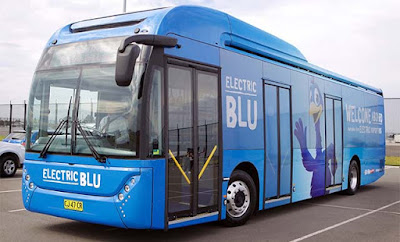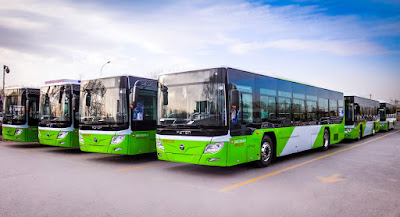EV charging complex has 25x chargers at 360kW and 5x chargers at 90kW; maintaining a capacity for Ultra-fast charging 30 urban transit buses at the same time
Equipped with Microvast's ultra-fast charging battery, a Foton electric bus stops by a charging point after a few loops of operation. Trained staff plug in the charger and within 10-15 minutes the electric bus's battery is refilled to maximum operating capacity and ready to go again. This now happens everyday in many bus terminals across metropolitan Beijing with the deployment of this cutting edge charging technology. Among all the ultra-fast charging stations, the newly opened charging station in Xiaoying Public Transit Bus Terminal is the largest.
Located in Chaoyang district, Beijing, built by China State Grid, this new charging complex covers an area of 26,500 m2 with its structures covering 1,575m2. Designed to satisfy the growing charging demand especially from the increase of ultra-fast charging electric buses departing from this terminal, this complex provides the infrastructure to charge 30 buses at the same time.
Originally a natural gas hybrid bus fleet, Beijing transit route 13 with Foton buses, like ten plus other major city bus routes departed from Xiaoying Terminal, now completely converted to ultra-fast charging full electric bus fleet. They join hundreds of other E-buses in Beijing already deployed using the same battery technology from Microvast.
After conversion to ultra-fast charging technology, the Route 13 fleet has improved operating efficiency while reducing Beijing's GHG emissions. Each new bus takes only 10-15 minutes to complete recharging the battery. Charging each bus takes place 2-3 times per day, during driver breaks, with several route loops between each charge.
Compared to earlier battery swapping system adopted by Beijing to experiment on improving Slow-charge Battery E-bus's operating efficiency and reduce down-time, the ultra-fast charging "battery + charger" system needs neither the investment and large storage space footprint for extra batteries, nor high cost complex with automated robotic battery pack swapping infrastructure, bringing obvious advantages to customers and utility companies with more rapid ROI.
With future facility and charging point expansions already planned out for 2016-2020, to accommodate more routes converting to fast charge EV, Xiaoying Terminal Charge station will play a greater role in the development of clean energy public transit system for Beijing in the near future.

 Fall is approaching, which means it's time for the auto-show season to get underway once again. Press days for the 2016 Paris Motor Show begin at the end of this month, and we already know several notable green production and concept cars will make their debuts in the French capital. The show's organizers say no fewer than 24 electric cars will...
Fall is approaching, which means it's time for the auto-show season to get underway once again. Press days for the 2016 Paris Motor Show begin at the end of this month, and we already know several notable green production and concept cars will make their debuts in the French capital. The show's organizers say no fewer than 24 electric cars will...  Fall is approaching, which means it's time for the auto-show season to get underway once again. Press days for the 2016 Paris Motor Show begin at the end of this month, and we already know several notable green production and concept cars will make their debuts in the French capital. The show's organizers say no fewer than 24 electric cars will...
Fall is approaching, which means it's time for the auto-show season to get underway once again. Press days for the 2016 Paris Motor Show begin at the end of this month, and we already know several notable green production and concept cars will make their debuts in the French capital. The show's organizers say no fewer than 24 electric cars will...  One of the challenges of making and selling electric cars is that their batteries are still expensive. And despite some makers' absorbing losses on the earliest cars, that means they sell for prices higher than those of similarly sized vehicles with combustion engines. Sure, owners will save money on running costs—but most shoppers will...
One of the challenges of making and selling electric cars is that their batteries are still expensive. And despite some makers' absorbing losses on the earliest cars, that means they sell for prices higher than those of similarly sized vehicles with combustion engines. Sure, owners will save money on running costs—but most shoppers will...  French automaker Renault hasn't sold nearly as many electric cars as its alliance partner Nissan. But Renault has steadily increased its electric-car sales volumes, particularly in Europe, with its main focus on the subcompact Zoe hatchback. That allowed the company to pass a notable milestone recently. DON'T MISS: Nissan and Renault together now...
French automaker Renault hasn't sold nearly as many electric cars as its alliance partner Nissan. But Renault has steadily increased its electric-car sales volumes, particularly in Europe, with its main focus on the subcompact Zoe hatchback. That allowed the company to pass a notable milestone recently. DON'T MISS: Nissan and Renault together now...  The word "contagious" is often used to describe diseases, but not all contagions are necessarily bad. Studies have found that solar panels can be "contagious," for example. In other words, a homeowner is more likely to install solar panels on their house if their neighbor has done so. CHECK OUT: Electric Cars Vs. Solar Panels: Which One's The...
The word "contagious" is often used to describe diseases, but not all contagions are necessarily bad. Studies have found that solar panels can be "contagious," for example. In other words, a homeowner is more likely to install solar panels on their house if their neighbor has done so. CHECK OUT: Electric Cars Vs. Solar Panels: Which One's The... 




